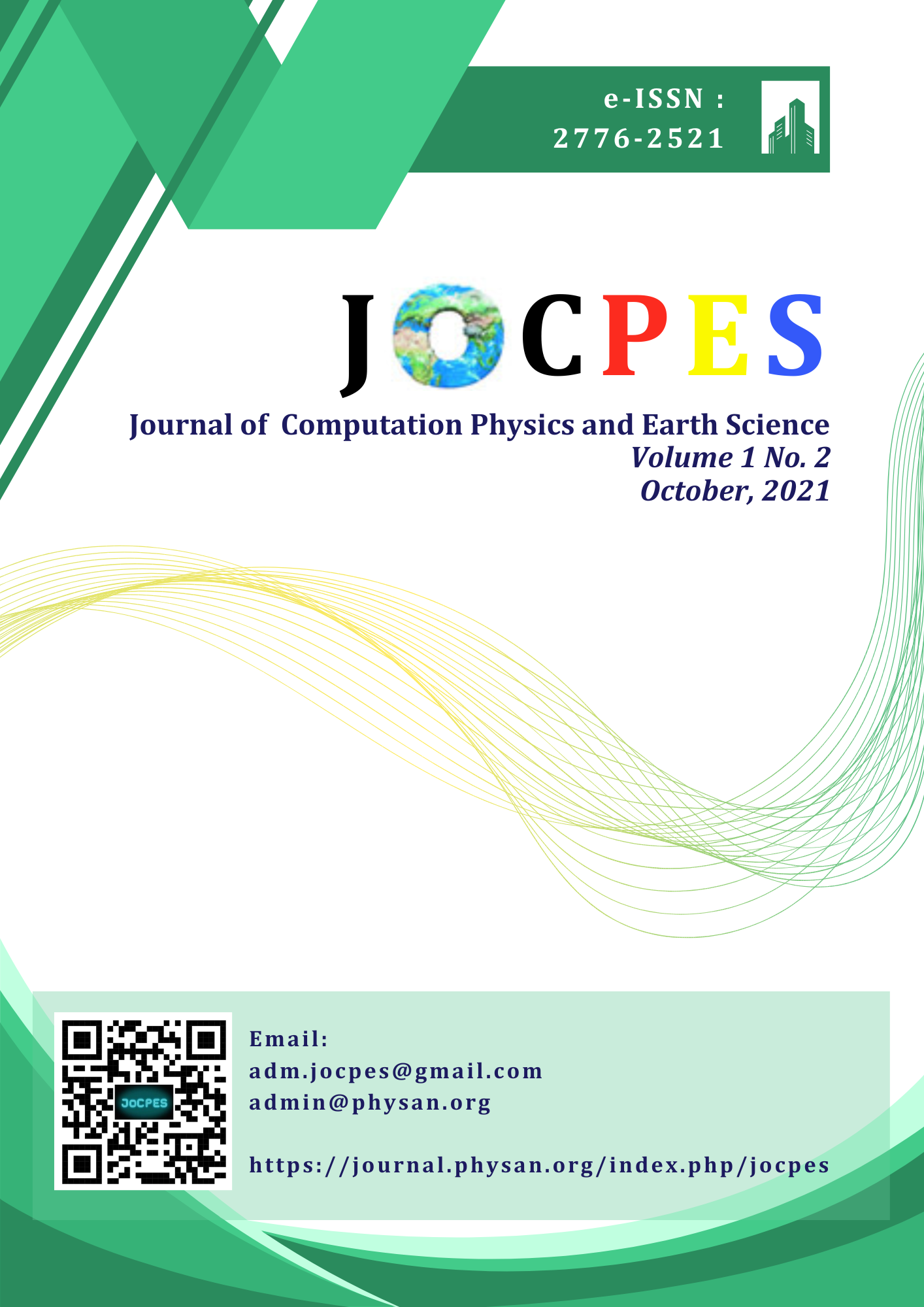A Review: Information Technology-based Climate Data Dissemination
Main Article Content
Abstract
Changes in climate indicators can cause extreme weather and can trigger disasters, such as floods and droughts and even crop failure. it is difficult to predict because farmers and local governments do not understand the importance of climate information, the solution to the problem is to disseminate and disseminate information, but requires an information system that is also inseparable from software, IoT-based applications, and others. With the method used, namely by classifying the climate based on rainfall. In classifying the climate, the oldeman and schmidt-ferguson classifications are used. Then the dataset is formed to calculate the degree or probability of the rainfall category and the Data Normality test. The test results show that the classification of rainfall categories with light, normal, and heavy categories is 79.5%, 40.9%, and 86.4% respectively. While the precision is 96.4%, 42.6%, and 83.3% respectively. Therefore, in making applications as a medium for disseminating information, it is necessary to understand the process of seasonal occurrence, and how to turn these data into information that can be utilized by the wider community.
Downloads
References
Y. Sarvina, “Pemanfaatan Software Open Source ‘ R ’ Untuk Penelitian Agroklimat ‘ R ’ Open Source Software for Agroclimate Research,” Inform. Pertan., vol. 26, no. 1, pp. 23–30, 2017.
H. Subyantara et al., “Penggunaan Mqtt Sebagai Optimasi Pengiriman Data Aaws Sebagai Sarana Sekolah Lapang Iklim Berbasis Internet of Things (Iot),” J. Meteorol. Klimatologi dan Geofis., vol. 5, no. 1, pp. 1–10, 2018, [Online]. Available: www.mqtt.org
D. Tarmana and A. Ulfah, “Peningkatan Pemahaman Informasi Iklim Melalui Sekolah Lapang Iklim (Sli) Bagi Petani,” JMM (Jurnal Masy. Mandiri), vol. 5, no. 2, pp. 798–809, 2021.
I. L. Mranoto, “PERANCANGAN SISTEM INFORMASI DATA PENGAMATAN AGROKLIMAT BERBASIS WEBSITE,” 2019.
N. Singh, S. Chaturvedi, and S. Akhter, “Weather Forecasting Using Machine Learning Algorithm,” 2019 Int. Conf. Signal Process. Commun. ICSC 2019, pp. 171–174, 2019, doi: 10.1109/ICSC45622.2019.8938211.
I. Fitriyaningsih, Y. Basani, and L. M. Ginting, “Machine Learning: Prosperity of Rainfall, Water Discharge, and Flood With Web Application in Deli Serdang,” J. Penelit. Komun. Dan Opini Publik, vol. 22, no. 2, 2018, doi: 10.33299/jpkop.22.2.1752.
C. J. Huang, M. C. Liu, S. S. Chu, and C. L. Cheng, “Application of machine learning techniques to Web-based intelligent learning diagnosis system,” Proc. - HIS’04 4th Int. Conf. Hybrid Intell. Syst., pp. 242–247, 2005, doi: 10.1109/ichis.2004.25.
I. G. E. Gunartha, “APLIKASI METODE KEKERINGAN PADA PENDUGAAN DATA IKLIM/CUACA’,” 1995.
F. Irsyad, E. G. Ekaputra, and A. Assyaukani, “Kajian Perubahan Iklim Pada Penentuan Jadwal Tanam Cabai Di Kabupaten Agam,” J. Teknol. Pertan. Andalas, vol. 23, no. 1, p. 91, 2019, doi: 10.25077/jtpa.23.1.91-102.2019.
I gede aris gunadi, “Klasifikasi Curah Hujan di Provinsi Bali Berdasarkan Metode Naïve Bayesian,” Wahana Mat. dan Sains J. Mat. Sains, dan Pembelajarannya, vol. 12, no. 1, pp. 14–15, 2018, [Online]. Available: https://ejournal.undiksha.ac.id/index.php/JPM/article/view/pril2018-2
E. A. Hussein, M. Ghaziasgar, C. Thron, M. Vaccari, and A. Bagula, “Basic statistical estimation outperforms machine learning in monthly prediction of seasonal climatic parameters,” Atmosphere (Basel)., vol. 12, no. 5, 2021, doi: 10.3390/atmos12050539.
E. Gumilanggeng, “Visualisasi Informasi Klasifikasi Iklim Koppen Menggunakan Metode Polygon Thiessen (Studi Kasus Provinsi Jawa Tengah),” pp. 6–22, 2013.
A. Mihai, G. Czibula, and E. Mihuletc, “Analyzing Meteorological Data Using Unsupervised Learning Techniques,” Proc. - 2019 IEEE 15th Int. Conf. Intell. Comput. Commun. Process. ICCP 2019, pp. 529–536, 2019, doi: 10.1109/ICCP48234.2019.8959777.
A. Zakir, “Analisis dan Pengembangan Sistem Metode Prakiraan Cuaca di Bidang Informasi Meteorologi,” p. 1, 2005.
Doreswamy, I. Gad, and B. R. Manjunatha, “Performance evaluation of predictive models for missing data imputation in weather data,” 2017 Int. Conf. Adv. Comput. Commun. Informatics, ICACCI 2017, vol. 2017-Janua, pp. 1327–1334, 2017, doi: 10.1109/ICACCI.2017.8126025.
N. Giarsyani, “Komparasi Algoritma Machine Learning dan Deep Learning untuk Named Entity Recognition : Studi Kasus Data Kebencanaan,” Indones. J. Appl. Informatics, vol. 4, no. 2, p. 138, 2020, doi: 10.20961/ijai.v4i2.41317.
D. Susilokarti, S. S. Arif, S. Susanto, and L. Sutiarso, “IDENTIFIKASI PERUBAHAN IKLIM BERDASARKAN DATA CURAH HUJAN DI WILAYAH SELATAN JATILUHUR KABUPATEN SUBANG, JAWA BARAT (Identification of Climate Change Based on Rainfall Data in Southern Part of Jatiluhur, Subang District, West Jawa),” J. Agritech, vol. 35, no. 01, p. 98, 2015, doi: 10.22146/agritech.13038.
C. He, J. Wei, Y. Song, and J. J. Luo, “Seasonal prediction of summer precipitation in the middle and lower reaches of the yangtze river valley: Comparison of machine learning and climate model predictions,” Water (Switzerland), vol. 13, no. 22, 2021, doi: 10.3390/w13223294.
K. Yelick, “Computing and Data Challenges in Climate Change,” pp. xix–xix, 2021, doi: 10.1109/hipc50609.2020.00009.
F. Sains and U. Diponegoro, “Klasifikasi Curah Hujan di Kota Semarang Menggunakan Machine Learning Rainfall Classification in the Semarang City Using Machine Learning,” vol. 1, no. 1, pp. 1–5, 2022.

